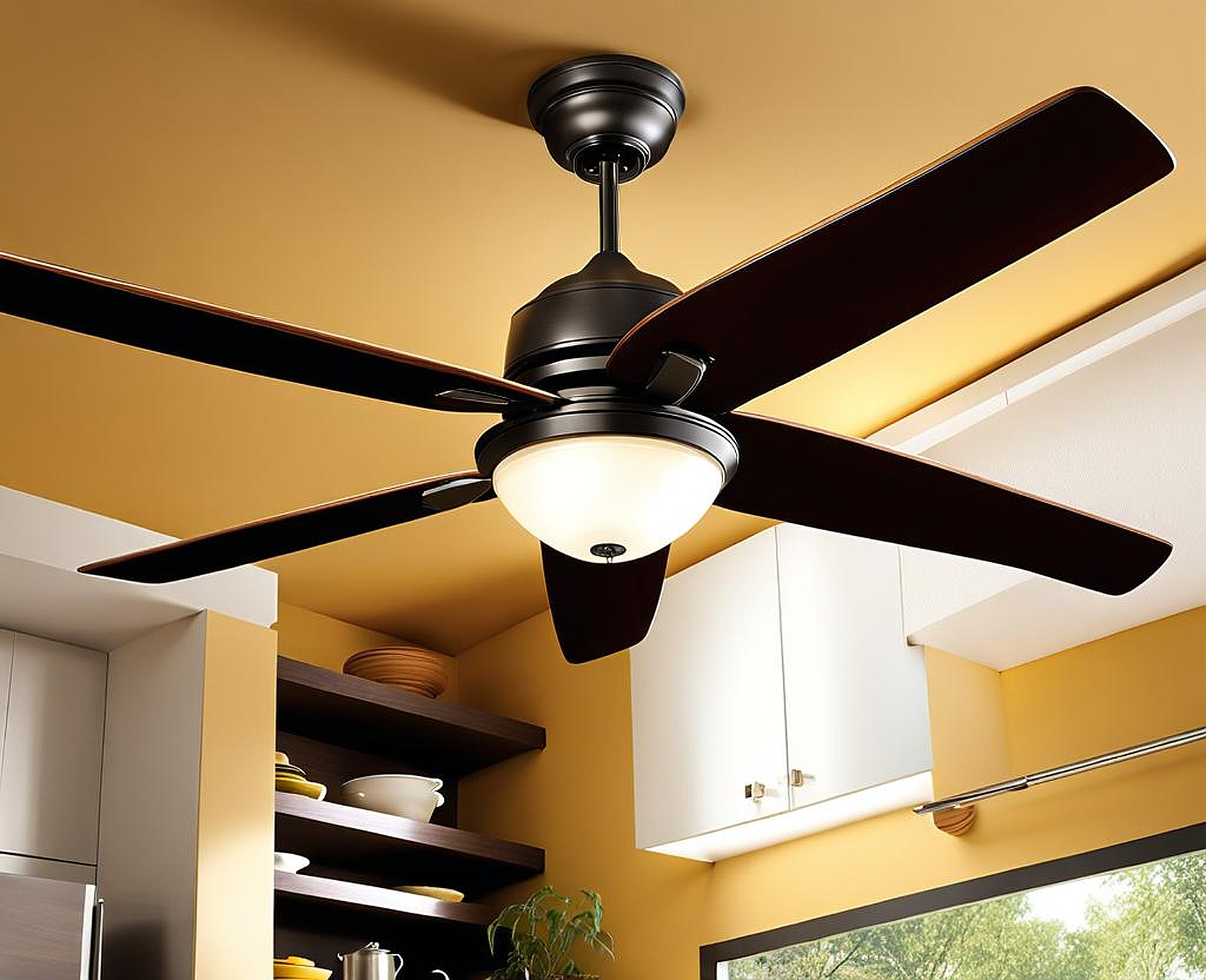Kitchens are the heart of every home, where culinary magic happens and memories are created. As a multifunctional space, it’s essential to strike the perfect balance between aesthetics and functionality. One element that seamlessly blends these two aspects is the humble ceiling fan in the kitchen. Often overlooked, this unsung hero not only enhances air circulation but also adds a touch of style to your cooking haven.
Importance of Ceiling Fans in Kitchen Design
Kitchens can quickly become hot and stuffy, especially during those marathon cooking sessions. With multiple appliances running simultaneously and the heat generated from stovetops and ovens, the air can become stagnant and uncomfortable. Enter the ceiling fan – a simple yet effective solution to combat heat buildup and promote better air circulation. By gently pushing the air around, ceiling fans create a refreshing breeze that keeps the kitchen environment pleasant and inviting.
Beyond their practical benefits, ceiling fans also offer a stylish touch that can elevate the overall aesthetic of your kitchen. Available in a wide array of designs, from sleek and modern to rustic and vintage, these versatile fixtures can seamlessly complement your kitchen’s decor. They serve as a focal point, drawing the eye upward and adding visual interest to the space.
Factors to Consider When Choosing a Kitchen Ceiling Fan
When it comes to incorporating a ceiling fan into your kitchen layout, there are several factors to consider to ensure optimal performance and aesthetics.
- Size: Measure the dimensions of your kitchen to determine the appropriate fan size. A fan that’s too small will be ineffective, while one that’s too large can overwhelm the space and create an unbalanced look.
- Blade Span: The blade span of the fan should be proportional to the size of your kitchen. As a general rule, larger kitchens require fans with a wider blade span to effectively circulate air.
- Mounting Height: Proper mounting height is crucial for efficient air circulation and safety. Most experts recommend installing the fan at least 7 feet above the floor, ensuring it won’t interfere with your movements or pose a hazard.
- Style and Finish: Consider the overall aesthetic of your kitchen when selecting the fan’s style and finish. Whether you prefer a sleek, modern design or a rustic, farmhouse vibe, there’s a ceiling fan to complement your vision.
Incorporating Ceiling Fans into Kitchen Layout and Ventilation
Integrating a ceiling fan into your kitchen layout requires careful planning and consideration of ventilation needs. Proper placement is key to maximizing the fan’s efficiency and ensuring optimal air circulation throughout the space.

One strategic location is directly above the cooktop or oven area. By positioning the fan in this high-heat zone, you can effectively disperse hot air and prevent it from lingering, creating a more comfortable cooking environment. It’s important to note that ceiling fans should never be installed directly above an open flame, as this could pose a fire hazard.
| Kitchen Layout | Recommended Fan Placement |
|---|---|
| Galley Kitchen | Install the fan along the central axis, parallel to the walls |
| L-Shaped or U-Shaped Kitchen | Position the fan in the center of the main workstation area |
| Open-Concept Kitchen | Consider multiple fans or a larger model to accommodate the open space |
Additionally, ceiling fans can work in tandem with your kitchen’s ventilation system to ensure optimal air circulation. By strategically positioning the fan near windows or vents, you can enhance cross-ventilation and create a continuous flow of fresh air throughout the space.
Aesthetic Appeal: Ceiling Fan Styles for Kitchen Decor
Beyond their functional benefits, ceiling fans offer an opportunity to infuse your kitchen with a touch of personal style. With a vast array of design options available, you can easily find a fan that complements your kitchen’s aesthetic and elevates the overall ambiance.
For a modern, sleek look, consider minimalist designs with clean lines and contemporary finishes like brushed nickel or matte black. These fans often feature energy-efficient LED lighting, adding both illumination and sophistication to your kitchen.
If your kitchen leans towards a more traditional or farmhouse vibe, opt for fans with rustic wood blades or vintage-inspired designs. These charming additions can add warmth and character to your space, seamlessly blending with your existing decor.
Don’t be afraid to experiment with bold colors or unique blade shapes for a statement-making centerpiece. A vibrant pop of color or an unexpected design can inject personality into your kitchen and serve as a conversation starter during gatherings.
To truly harness the power of your kitchen ceiling fan and ensure optimal efficiency and comfort, consider these practical tips:
- Proper Installation: Enlist the help of a professional electrician to ensure your ceiling fan is installed correctly and securely. Improper installation can lead to safety hazards and diminished performance.
- Seasonal Adjustments: Most ceiling fans have a reversible motor that allows you to change the direction of the airflow. In the summer, set the fan to spin counterclockwise, creating a cooling downdraft. During cooler months, reverse the direction to clockwise for a gentle upward draft that can help circulate warm air.
- Lighting Integration: Many ceiling fans come equipped with built-in lighting fixtures, eliminating the need for separate overhead lighting. Look for models with dimmable or adjustable lighting to create the perfect ambiance for any occasion.
- Remote Control: Invest in a ceiling fan with a remote control for added convenience. This allows you to adjust the speed or turn the fan on and off without having to reach for the pull-chain or wall switch.
By thoughtfully incorporating a ceiling fan into your kitchen layout and design, you can create a space that is not only visually stunning but also comfortable and functional. Embrace the versatility of this humble fixture and let it elevate your culinary haven to new heights.